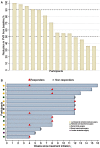Effects of electroacupuncture on pediatric chronic urinary retention: a case-series study
- PMID: 37547105
- PMCID: PMC10401264
- DOI: 10.3389/fped.2023.1194651
Effects of electroacupuncture on pediatric chronic urinary retention: a case-series study
Abstract
Objectives: This study aims to preliminarily evaluate the effect and safety of electroacupuncture (EA) in treating pediatric chronic urinary retention (CUR) following lumbosacral surgeries, with treatment duration evaluated.
Methods: This prospective case-series study was performed from August 5, 2017, to July 31, 2022. Pediatric patients diagnosed with CUR following lumbosacral surgeries were included and treated by EA for 2-16 weeks. Responders were defined as participants achieving a reduction of 50% or more in post void residuals (PVR) from baseline. Time-to-event analysis was applied to explore the association between EA treatment duration and response rate. Adverse event was recorded.
Results: Totally 14 participants (mean [SD] age, 12 [4] years) completed EA treatment. Response rate was 71% (10/14) at the 12th week. 50% (7/14) of participants removed catheters at the 12th week, and none of them experienced re-catheterization in the 24-week follow-up. No serious adverse event was reported. Time-to-event analysis estimated that over 50% patients could respond to EA of more than 8 weeks. Subgroup analysis showed that participants with baseline PVR ≥300 ml and CUR duration ≥12 months experienced longer EA duration to reach the response rate of 50%, compared with those whose PVR <300 ml and CUR duration <12 months (median value: 12 weeks vs. 8 weeks, 12 weeks vs. 4 weeks, respectively).
Conclusions: EA could reduce PVR for pediatric patients suffering from CUR following lumbosacral surgeries, with long-term efficacy and safety. EA treatment of more than 8 weeks was reasonable. Further study of a larger sample and controlling is needed.
Clinical trial registration: www.chictr.org.cn, identifier, ChiCTR1800020222.
Keywords: case-series; chronic urinary retention; electroacupuncture; lumbosacral surgeries; pediatric patients.
© 2023 Yang, Gao, Yao, He, Fang, Chen and Liu.
Conflict of interest statement
The authors declare that the research was conducted in the absence of any commercial or financial relationships that could be construed as a potential conflict of interest.
Figures


Similar articles
-
Effects of electroacupuncture on chronic urinary retention after pelvic or lumbosacral tumor resection surgeries: a retrospective cohort study.Transl Androl Urol. 2024 Mar 31;13(3):397-405. doi: 10.21037/tau-23-468. Epub 2024 Mar 14. Transl Androl Urol. 2024. PMID: 38590962 Free PMC article.
-
Effects of electroacupuncture on patients with chronic urinary retention caused by a lower motor neuron lesion: An exploratory pilot study.Medicine (Baltimore). 2020 Jan;99(1):e18615. doi: 10.1097/MD.0000000000018615. Medicine (Baltimore). 2020. PMID: 31895816 Free PMC article.
-
Effect of Electroacupuncture on Insomnia in Patients With Depression: A Randomized Clinical Trial.JAMA Netw Open. 2022 Jul 1;5(7):e2220563. doi: 10.1001/jamanetworkopen.2022.20563. JAMA Netw Open. 2022. PMID: 35797047 Free PMC article. Clinical Trial.
-
Efficacy and safety of electroacupuncture for post stroke depression: study protocol for a randomized controlled trial.Trials. 2018 Mar 2;19(1):152. doi: 10.1186/s13063-018-2548-0. Trials. 2018. PMID: 29499745 Free PMC article.
-
Chronic urinary retention in men: how we define it, and how does it affect treatment outcome.BJU Int. 2012 Dec;110(11):1590-4. doi: 10.1111/j.1464-410X.2012.11101.x. Epub 2012 Mar 27. BJU Int. 2012. PMID: 22452619 Review.
Cited by
-
Electroacupuncture Pretreatment Attenuates Learning Memory Impairment Induced by Repeated Propofol Exposure and Modulates Hippocampal Synaptic Plasticity in Rats.J Inflamm Res. 2023 Oct 16;16:4559-4573. doi: 10.2147/JIR.S427925. eCollection 2023. J Inflamm Res. 2023. PMID: 37868829 Free PMC article.
References
LinkOut - more resources
Full Text Sources
Research Materials

